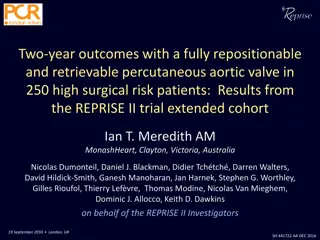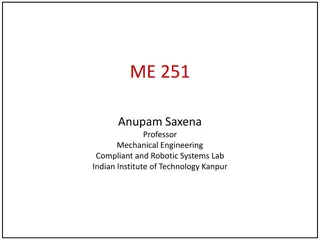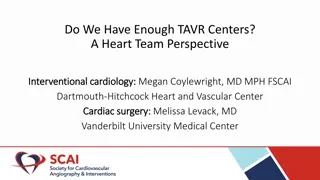Advances in Trans-Catheter Aortic Valve Replacement: A Comprehensive Review
This presentation explores the evolution of Trans-Catheter Aortic Valve Replacement (TAVR), highlighting historical milestones, anatomical considerations, the role of Balloon Aortic Valvuloplasty, current guidelines, the need for TAVI, and a notable case study by Dr. Cribier. The content discusses the shift towards minimally invasive techniques in addressing aortic stenosis, outlining the growing importance of TAVR in treating patients deemed unsuitable for surgery or seeking quicker recovery options.
Download Presentation

Please find below an Image/Link to download the presentation.
The content on the website is provided AS IS for your information and personal use only. It may not be sold, licensed, or shared on other websites without obtaining consent from the author.If you encounter any issues during the download, it is possible that the publisher has removed the file from their server.
You are allowed to download the files provided on this website for personal or commercial use, subject to the condition that they are used lawfully. All files are the property of their respective owners.
The content on the website is provided AS IS for your information and personal use only. It may not be sold, licensed, or shared on other websites without obtaining consent from the author.
E N D
Presentation Transcript
TRANS-CATHETER AORTIC VALVE REPLACEMENT DR.M.S.SHIVENDRRAN CIII UNIT SEMINAR PRESENTATION
REFERENCES The Lancet jan 1986 Braunwald 12th edition Catherine Otto, Valvular Heart Disease, Companion To Braunwald Heart Disease The PCR EAPCI Textbook
ANATOMY OF AORTIC ROOT: 1)Aortic Valve Cusp 2)Aortic Valve Annulus 3)Aortic Root Complex
HISTORY: SAVR(1960s) was the only treatment for Aortic stenosis for more than 4 decades Low mortality in good surgical candidates Return to normal life expectancy Declined in 1/3 of cases
1985, Cribier and Colleagues introduced Balloon Aortic Valvuloplasty as an alternative to SAVR in inoperable pts. Symptomatic improvement No effect on long term survival Early valvular restenosis
BAV STILL IN USE? ACC/AHA GUIDELINES(2014): Bridge to TAVR/SAVR in severe symptomatic AS ESC GUIDELINES(2012):Urgent non cardiac surgery and palliation of symptoms Remain integrated to many TAVR procedures (pre/post dilatation , Balloon Interogation)
NEED FOR TAVI? 1/3 patients in real world are deemed unsuitable for surgery Elderly patients are reluctant after SAVR counselling People prefer Minimally invasive techniques and quick discharge.
Dr. Cribier;(2002) 57/m pt with Inoperable AS (Bicuspid aortic valve) Ejection fraction -10% Cardiogenic shock Intra lv thrombus Blocked femoral arteries 23mm Bovine Pericardial Balloon expandable stent valve with 24Fr catheter delivery system(transeptal approach) Good results
FIRST SERIES(ROUEN,2002-2004) 40 CRITICAL CASES I-REVIVE/RECAST TRIAL Transseptal approach(80%) Retrograde approach(20%) PVL> Grade 2 (25%) 5 patients survived > 5 years
In subsequent studies, retrograde approach via femoral artery was done.(predominant approach today) In 2007,Trans-apical approach was introduced.
AORTIC STENOSIS Incidence of Aortic stenosis 2% of pts more than 65 years 12% above 75 years has Aortic stenosis 3.4% above 75 years has Severe Aortic stenosis
CANDIDATES FOR INTERVENTION: Symptomatic severe aortic stenosis(D1,D2.D3) (class I)
ASYMPTOMATIC SEVERE AORTIC STENOSIS 1) EF<50% (class I) 2) Other heart surgeries(+CABG) (class I) 3) Abnormal exercise stress testing (class IIa) 4) V max > 5m/s (Very severe Aortic stenosis) (class IIa) 5) BNP > x 3 times ULN (class II a) 6) Rapid progression of disease(V max > 0.3m/s)(class IIa) IIb Indications- 1)excessive LVH and no HTN ; 2)mean gradient> 20mm increase with excercise
DECISION MAKING FACTORS FAVORING SAVR FAVORING TAVR FAVORING PALLIATION AGE AND LIFE EXPECTANCY Younger age(<65 year) Longer life expectancy Older age (>80 years) Few expected remaining years of life (only 5 year data available) Limited life expectancy PROSTHETIC VALVE PREFERENCE Mechanical or surgical Bioprosthesis valve preferred Concern for patient prosthesis mismatch Bioprosthesis valve preferred FROM:Eurheartj/goals of care in patients with aortic stenosis
DECISION MAKING FACTORS FAVORING SAVR FAVORING TAVR FAVORING PALLIATION VALVE ANATOMY 1)Bicuspid aortic valve 2)Rheumatic HD 3)Small or Large aortic annulus 4)Coronary ostial heigth 1)Calcific AS of a trileaflet valve Bicuspid valve: 1)Oval annulus, 2)Unequal leaflet size, 3)Heavy/uneven calcification,calfied raphe, 4)associated Aortopathy Large annulus not suitable for current transcatheter valve size Small aortic annulus or aorta- surgical annular enlarging is required
DECISION MAKING FACTORS FAVORING SAVR FAVORING TAVR FAVORING PALLIATION CONCURRENT CARDIAC CONDITIONS 1)Aortic dilation 2)Severe Primary MR 3)Severe CAD requiring Bypass graft 4)Septal hypertrophy requiring myomectomy 5)Atrial fibrillation Severe calcification of ascending aorta (Porcelein aorta) 1)Irreversible severe lv systolic dysfunction 2)Severe MR due to annular calcification Severe AS and Severe primary MR -> SAVR and combined Mitral valve surgery High risk surgery- TAVI+ mitral valve edge to edge repair Secondary MR improves after TAVI
DECISION MAKING FACTORS FAVORING SAVR FAVORING TAVR FAVORING PALLIATION CONCURRENT CARDIAC CONDITIONS 1)Aortic dilation 2)Severe Primary MR 3)Severe CAD requiring Bypass graft 4)Septal hypertrophy requiring myomectomy Severe calcification of ascending aorta (Porcelein aorta) 1)Irreversible severe lv systolic dysfunction 2)Severe MR due to annular calcification In presence of complex left main and/or multivessel disease with SYNTAX >33, SAVR with CABG preferred Severe CAD- impaired mid and long term outcomes after TAVI Coronary access may be challenging in proportion of patients after TAVR. THV with low commissure height and large open cells may help in access of coronary ostia
DECISION MAKING FACTORS FAVORING SAVR FAVORING TAVR FAVORING PALLIATION NON CARDIAC CONDITIONS Severe lung disease, liver disease and renal disease Mobility issues High risk for sternotomy 1)Symptoms due to non cardiac conditions 2)Severe dementia 3)Involvement of two or more other organ FRAILITY Not frail or few fraility measures Fraility likely to improve after AVR Severe Fraility unlikely to improve after AVR FROM:Eurheartj/goals of care in patients with aortic stenosis
DECISION MAKING FACTORS FAVORING SAVR FAVORING TAVR FAVORING PALLIATION SURGICAL RISK TAVR RISK HIGH Chest irradiation\ TAVR RISK LOW TO MEDIUM GOALS OF CARE 1)Accepts longer hospital stay 2)Pain in recovery period 3)Lower risk of permanent pacer 4)Avoid repeat intervention 5)Avoids vascular complications 1)Prefers shorter stay 2)Less periprocedural pain 3)High risk of permanent pacer 4)Possible repeat intervention 1)Life expectancy post procedure <1 year 2)Avoid procedural stroke risk 3)Avoid possibility of cardiac pacer FROM:Eurheartj/goals of care in patients with aortic stenosis PATIENTS PREFERENCE
SURGICAL RISK : STS PROM AT 30 DAYS LOW: <4% INTERMEDIATE: 4-8% HIGH: 8-15% PROHIBITIVE: >15% Recent RCTs have used STS in Stratifying patients. Clinical risk assessment, anatomic characterstics And functional assessment are vital for optimal TAVI results
IMAGING MODALITIES IN TAVI ACCESS EVALUATION-ILIOFEMORAL 1)CT 2)ANGIO 3)IVUS/DOPPLER + PLAIN CT DEVICE SIZING 1)TTE 2)TEE 3)ICE 4)CT ANGIO/MDCT 5)ANGIO WITH BALLOON INTEROGATION
MONITORING OF COMPLICATIONS: 1)HEAMODYANAMIC MONITORING 2)TEE 3)TTE/ICE 4)ANGIO POST PROCEDURE FOLLOW UP 1)LONG TERM VALVE FUNCTION
AORTIC VALVE COMPLEX: LEFT VENTRICULAR OUTFLOW TRACT AORTIC VALVE 1)Ectopic Calcification 1)Bicuspid vs Tricuspid / Valve opening 2)Aortic valve gradient and area 3)Aortic valve calcification and ectopic calcification 4)Other abnormalities(vegetation/masses) 2)Basal septal morphology AORTIC ROOT DIMENSION 1)Location of coronary ostia ANNULAR DIMENSION 1)Select suitable balloon and valve 2)Sinotubular dimensions and calcification
MITRAL VALVE/ TRICUSPID VALVE LEFT VENTRICULAR FUNCTION Severity of MR LV cavity size 1)Primary Wall motion 2)Secondary Ejection fraction Severity of Ectopic calcification Wall thickness Anterior leaflet calcification may affect placement of valve LV internal dimension Exclude LV thrombus
CT ANALYSIS Aortic root assessment Aortic annulus measurements for valve sizing Landing zone calcification Valve morphology Vascular anatomy
PROCEDURAL PLANNING USING CT Does the patient have adequate Transfemoral access Alternate access Precise stick location Awareness of high risk groups: 1)Balloons/covered stents availability 2)Adequate contralateral access 3)Blood product availability
VASCULAR ACCESS WORKUP Clinical evaluation CT angiogram Angiography MRI IVUS/DUPLEX/ PLAIN CT
ROLE OF CEREBRAL EMBOLIC PROTECTION To capture/deflect debris released during TAVI to reduce risk of stroke. FDA approved- Sentinel Cerebral Protection System- contains 2 filters placed in innominate artery and left carotid artery through right radial artery























